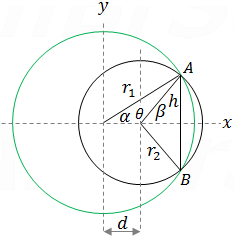Two spheres intersection summary

Now we can find the angle α and θ by the cosine law:
Once we found the angle α we can find the intersection circle radius h.
 The lapping volume between the two spheres contains two spherical caps the height of the spherical cap can be found by the same way as circular segment height.
The volume of the lapping area which contains the two spherical caps is:

The equation of a sphere can be described by the equation: x2 + y2 + z2 + Ax + By + Cz + D = 0
The connections of the coefficients A, B, C and D to eq. (1) are:
If both spheres are given in this form the distance d between spheres centers is:
 Sphere 1 radius is:
 If we subtract the two spheres equations from each other we receive the equation of the plane that passes through the intersection points of the two spheres and contains the circle AB.
X 2(x2 − x1) + Y 2(y2 − y1) + Z 2(z2 − z1) + x12 − x22 + y12 − y22 + z12 − z22 − r12 + r22 = 0 (3)
General plane equation is:
XA + YB + ZC + D = 0
where:
The equation of the line that connects the sphere’s centers is by parametric line equation
The center point of circle AB is located at the point of intersection of the parametric line connecting the spheres centers eq. (4) and the plane of the spheres intersection eq. (3) which also contains the circle AB.
By substituting eq. (4) into eq. (3) we can find the value of t which is:
(x1 + t x2 − t x1)A + (y1 + t y2 − t y1)B + (z1 + t z2 − t z1)C + D = 0
 Substitute the value of t into eq. (4) to get the coordinate of the intersection circle (AB) center.
|
||||||||||||||||||||||||||||||||||||||||||





